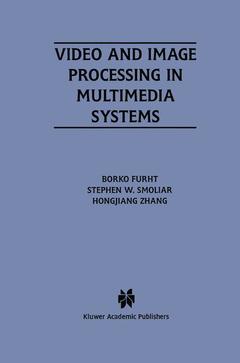Description
Video and Image Processing in Multimedia Systems, 1995
The Springer International Series in Engineering and Computer Science Series, Vol. 326
Authors: Furht Borko, Smoliar Stephen W., HongJiang Zhang
Language: English
Subjects for Video and Image Processing in Multimedia Systems:
Keywords
Multimedia; Processing; Standard; Standards; Text; Video; algorithms; communication; image processing
Approximative price 210.99 €
In Print (Delivery period: 15 days).
Add to cart
Publication date: 12-2012
377 p. · 15.5x23.5 cm · Paperback
377 p. · 15.5x23.5 cm · Paperback
Description
/li>Contents
/li>Comment
/li>
Video and Image Processing in Multimedia Systems treats a number of critical topics in multimedia systems, with respect to image and video processing techniques and their implementations. These techniques include:
This book serves as an invaluable reference with respect to the most important standards in the field. Video and Image Processing inMultimedia Systems is suitable as a textbook for course use.
- Image and video compression techniques and standards, and
- Image and video indexing and retrieval techniques.
This book serves as an invaluable reference with respect to the most important standards in the field. Video and Image Processing inMultimedia Systems is suitable as a textbook for course use.
Part I: Introduction to Multimedia. 1. Basic Concepts. 2. Multimedia Networking and Synchronization. 3. Overview of Multimedia Applications. References. Part II: Multimedia Compression Techniques and Standards. 4. Introduction to Multimedia Compression. 5. JPEG Algorithm for Full-Color Still Image Compression. 6. PX64 Compression Algorithm for Video Telecommunications. 7. MPEG Compression for Motion-Intensive Applications. 8. Other Multimedia Compression Techniques. 9. Imlementations of Compression Algorithms. 10. Applications of Compression Systems. References. Part III: Image and Video Indexing and Retrieval Techniques. 11. Content-Based Image Retrieval. 12. Content-Based Video Indexing and Retrieval. 13. Video Processing Using Compressed Data. 14. A Case Study in Video Parsing: Television News. References. Index.
This book treats a number of critical topics in multimedia systems, with respect to image and video processing techniques and their implementations. These techniques include : image and video compression techniques and standards, and image and video indexing and retrieval techniques. The first part serves as an introduction to multimedia systems, discussing basic concepts, multimedia networking and synchronization, and an overview of multimedia applications. Part two presents comprehensive coverage of image and video compression techniques and standards, their implementation and applications. In part three attention is focused on the semantic nature of image and video source material, and how that material may be effectively indexed and retrieved. Topics discussed include static images, fu
© 2024 LAVOISIER S.A.S.




